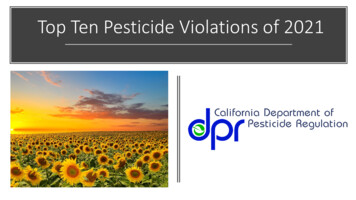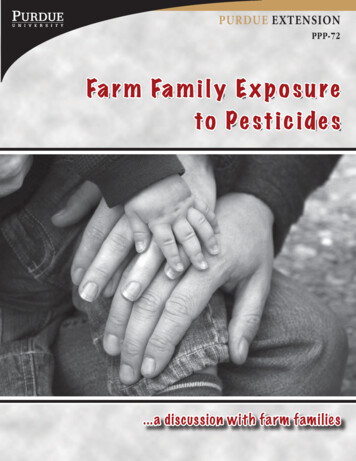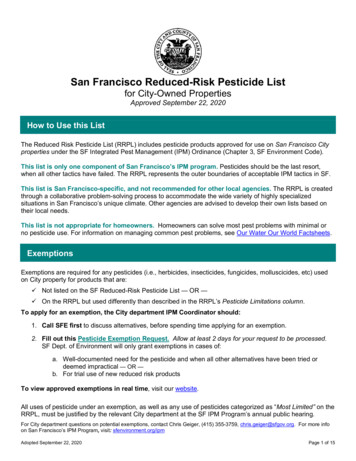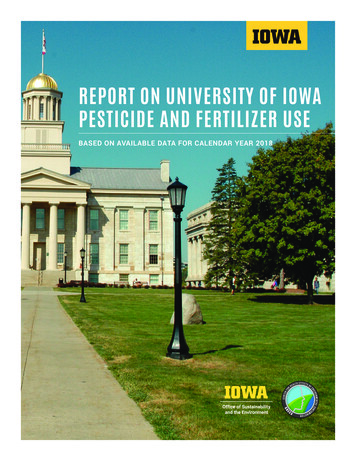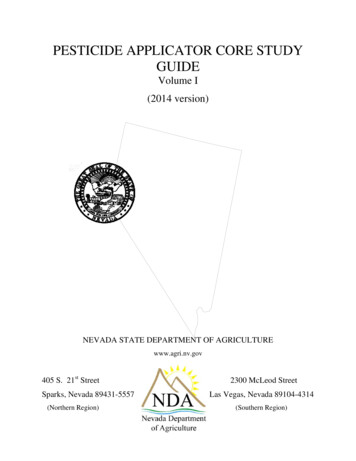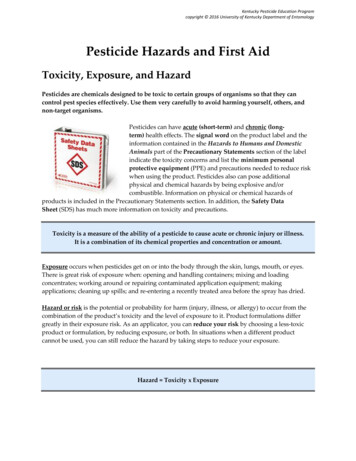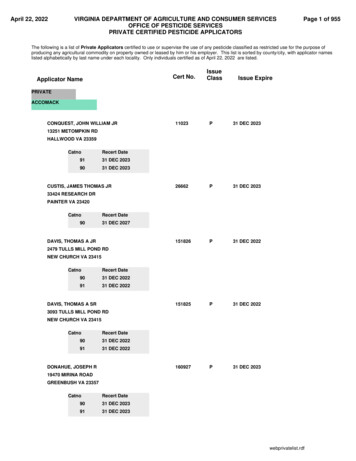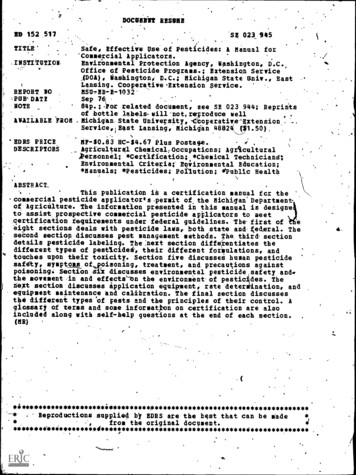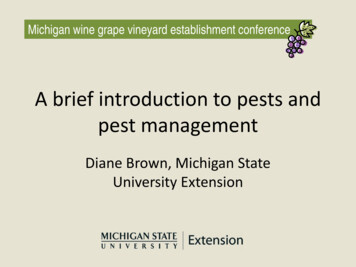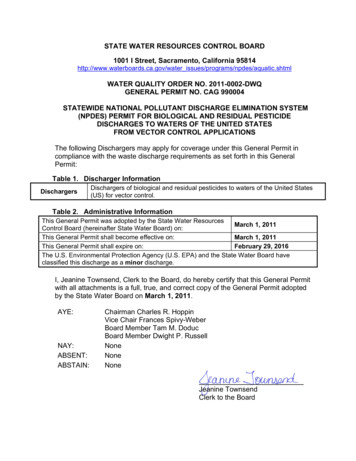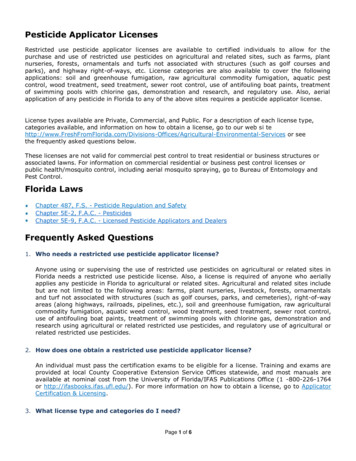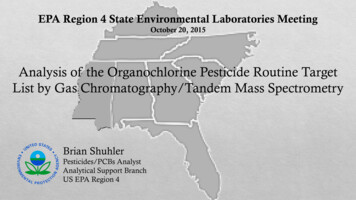
Transcription
EPA Region 4 State Environmental Laboratories MeetingOctober 20, 2015Analysis of the Organochlorine Pesticide Routine TargetList by Gas Chromatography/Tandem Mass SpectrometryBrian ShuhlerPesticides/PCBs AnalystAnalytical Support BranchUS EPA Region 4
Pesticide Analysis OverviewCurrently, all analyses for our routine organochlorine (OC) pesticides target list are run by Method 8081 on GC/ECD. ECD is a highly sensitive detector for compounds containing electronegative atoms or functional groups (halogens,organometallics, nitrites, nitro groups), and is capable of achieving (and exceeding) the low reporting limits required fortarget list OC pesticides.ECD response- 1 pg on column As a non-specific detector, target compound identification is achieved via agreement between sample chromatographicpeak retention time (RT) and the its expected retention time as determined during calibration. This must be confirmed by asecond dissimilar stationary phase column or other qualitative technique (e.g. GC/MS).This method performs very well if sample extracts are relatively free of interferences. Unfortunately, environmental sample extractsrarely meet this criterion.
Limitations of GC/ECD AnalysisDetector selectivityThe presence of reportable levels of technical toxaphene- a target pesticide on our routine listprecludes reporting of a large subset of single-component pesticides down to their MRLs.Toxaphene Standard at MRL LevelPesticide Standard MRL Level8081 SOP Target List
Limitations of GC/ECD AnalysisChemical interferencesEnvironmental analysis normally involves samples with very complex matrices (soil, tissue, waste), and these extracts often containhigh levels of co-extracted interferences.
Limitations of GC/ECD AnalysisChemical interferencesAqueous sample extracts from heavily contaminated sites can also have similar issues as a result of high levels of co-extractedinterferents.
Limitations of GC/ECD AnalysisChromatographic noise that decreases data quality is not anuncommon occurrence, and often results in more dataqualification than would otherwise be required.Clearly, detector selectivity is the limiting factor of GC/ECD.Improving the data quality depends most on improvingdetector specificity in order to reduce the levels ofinterferences that reach the detector, and/or reducing thelevel of these interferences in the sample extracts themselves.
Benefits of MS/MS DetectionMSMS is an obvious choice for targeted environmental analyses, due to the high level of selectivity that thedetector configuration is able to achieve. RT selectivity (e.g. ECD) m/z selectivity (e.g. MS-SIM) structure related selectivity (e.g. MSMS)Chemical noise in the chromatography is virtually eliminated, greatly improving S/N and detector sensitivity
GC/ECD and MSMS Comparison – Soil Sample ExtractECD Chromatogram
GC/ECD and MSMS Comparison – Soil Sample ExtractSoil Sample MS/MS Chromatogram
GC/ECD and MSMS Comparison – Water Sample ExtractWater Sample ECD Chromatogram
GC/ECD and MSMS Comparison – Water Sample ExtractWater Sample MS/MS Chromatogram
What toxaphene interference?GC/MSMS is able to analyze for toxaphene and all of the single component pesticides at one time. Through careful selection of precursor and product ions in the MSMS method, interference of toxaphene with the othertarget pesticides has been eliminated. As a result, instrument calibration requires only one set of calibration standards containing all the target compounds, anddemonstrates the capability to truly analyze for the entire target list down to the reporting limits in a single analysis.
MSMS OverviewEI70 eVDieldrin
MSMS OverviewStructure Related SelectivityEI70 eVQ1- Every sample componentwithin the RT window that producesions of the same m/z as precursorschosen for the target will passthrough the mass filter.PrecursorDieldrinPrecursor Ion
MSMS OverviewStructure Related SelectivityCollision energies are optimized foreach target precursor to generatethe greatest abundance of a desiredproduct m/z(s). Precursor ionscontributed from differentcompounds (target vs matrix) willhave a unique fragmentation patternbased on their structures.DieldrinEI70 eVPrecursorProduct Ion m/z
MSMS OverviewStructure Related SelectivityThe Q3 mass filter selects forproduct ions that were determinedby the target structure. Therefore,the resultant product ion spectrum is(almost) entirely due to the targetprecursor ion and not the chemicalbackground.DieldrinEI70 eVPrecursorProduct
MSMS OverviewEI70 eVPrecursorProduct
Performance of MSMS Method - Consistency Since instrumental method development was completed, all samples with reportable levels of any pesticides from ECDanalysis have been confirmed by GC/MSMS. MSMS and ECD analyses consistently agree in the identification of target compounds present in samples. MSMS analysis regularly yielded reportable concentrations of additional target pesticides in samples, which were masked inECD chromatograms by interference. The extent of comparative data gives a high level of confidence in the ability for MS/MS to generate data of equal or higherquality to that of ECD across a variety of sample matrices and project sites.
Performance of MSMS Method - Sensitivity
Performance of MSMS Method - Linearity
Performance of MSMS Method - AccuracyResults of “unofficial” analysis of a pesticide performance test sample (in µg/L).
Performance of MSMS Method - EfficiencyBetter data quality, easier data processing, fewer calibration standards, less sample dilutions,and a LOT less paper.ECD Project DataMS/MS Project Data(result confirmation analysis)GC/MSMS is a great instrument for targeted analyses in dirty samples,BUT
GC/MSMS is Not a PanaceaRegardless of the analytical approach, target analysis of OC pesticides in environmentalsamples presents significant analytical challenges due to a need to address both trace levelreporting limits and complex sample matrices. Sample cleanup is still a vital part of generating quality data! The analysis relies on retention time windows, which means thatsamples still need to be clean enough to chromatograph well, consistently. Interferences are still there, just masked from the detector. The reduction in chemical noise is great for targeted analyses, but it comes at a price- the target product ion abundances are all youget. No other spectral or chromatographic information is collected, so suspected issues will require re-analyses to investigate. Target sensitivity is low for structurally labile compounds that experience excessive fragmentation upon ionization or collisionactivated dissociation, particularly with some of the bicyclic pesticides (endrin, dieldrin). MRM transition databases are an expensive, quick way to set up an MSMS method, but there is no substitute for running the MRMexperiments on the instrument, with the whole target compound list together. Additionally, many compound transitions can befound online for free.
Current Status of GC-MSMS Pesticides Method Initial test method evaluation (ITME) and limit of detection (LOD) studies for all targets compounds was completed for both waterand soil matrices in January 2015. A standard operating procedure based on Methods 8270 and 8081 was finalized and posted in June 2015. Analysis of SESD’s routinepesticide list by GC/MSMS is now available as an alternative to the Method 8081 ECD analysis.Future Development of GC/MSMS Pesticides Method Method is scheduled for inclusion in the next round of routine performance test analyses, with the intention of adding to ourlaboratory’s ISO 17025 accreditation in the near future. Evaluating the use of softer chemical ionization for improved instrument sensitivity of labile target compounds Take advantage of the expanded capabilities of GC/EI or GC/CI MSMS to analyzes for any non-halogenated pesticides of interestto Region 4, and more broadly, any compounds of interest to the Region that are amenable to MSMS analysis
Thank You!
shuhler.brian@epa.gov706-355-8673Questions?
Benefits of MS/MS Detection MSMS is an obvious choice for targeted environmental analyses, due to the high level of selectivity that the detector configuration is able to achieve. RT selectivity (e.g. ECD) m/z selectivity (e.g. MS-SIM) structure related selectivity (e.g. MSMS)

